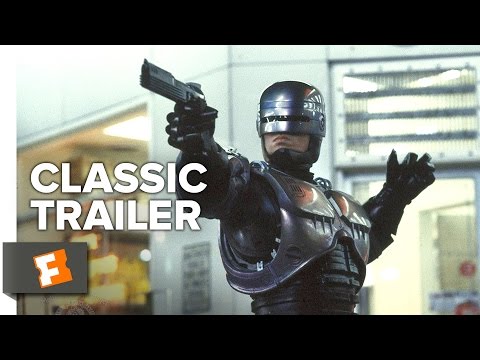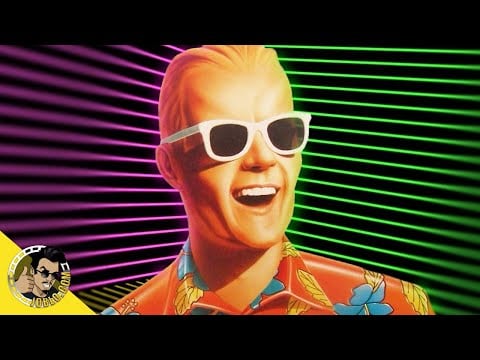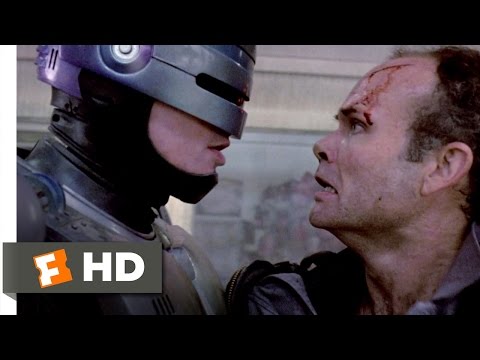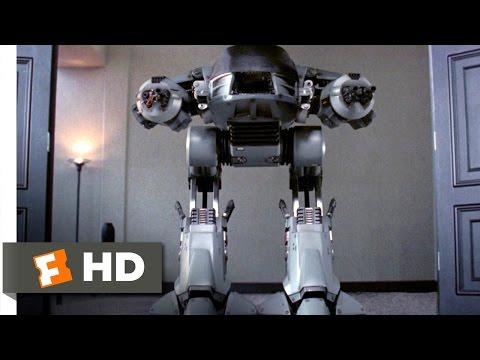Paul Verhoeven’s “RoboCop” (1987) felt like a crazed, positively cracked masterpiece when it first arrived.
Once audiences got past the B-movie moniker (surely no one at Orion Pictures thought we’d take the title seriously, right?), there was the film itself, a tortured hero’s journey dolled up in science fiction and presented as an uncompromised, state-of-the-art popcorn flick.

It begins in the not-too-distant future, in which the population is obsessed with television, surrounded by outbreaks of violence and at the mercy of corporations with far too much access to power. In other words, just like today. No date is given for the setting and none is needed.
The future is now.
Peter Weller’s Officer Murphy is a “transfer from Metro South,” immediately put on the streets and partnered with the aggressive Officer Lewis, played by Nancy Allen.
There’s coed nudity at this station, a precursor to Verhoeven’s “Starship Troopers” (1997), as well as a commentary on the nature of the force’s inner politics. Upon hearing word of a strike, the force’s Sgt. Reed (played by a terrific Robert DoQui) announces, “We’re policemen, not plumbers. Police officers don’t strike.”
It’s a small touch (“RoboCop 2” actually depicts the eventual police strike) but pivotal- this is a system that aims to control the humanity of those who serve it.
RELATED: ‘Child’s Play’ — A Perfectly Awful Remake
The world of the working-class criminals and the heavily padded/armed cops coalesces when Murphy and Lewis pursue Clarence Boddicker (a fantastic Kurtwood Smith) and his gang of loyal sickos. The hierarchy of rich men in suits, who hire monsters like Boddicker to carry out their wicked deeds, comes to ground level with Murphy’s infiltration of this criminal chain that starts at the top floor of Omni Consumer Products headquarters.
It’s worth noting that the bureaucrats calling the shots and their board room meetings are every bit as interesting as the action taking place at street-level. If there’s a worthy comparison, in terms of a protagonist struggling to maintain his true identity and humanity, while sharks in suits orchestrate chaos and corruption, this actually goes well alongside the cult 1987 TV series, “Max Headroom.”
Change OCP with Channel 54 and Murphy’s cop with Matt Frewer’s investigative reporter and the two have similar concepts and themes. Of course, whereas “Max Headroom” had late ’80s TV standards, Verhoeven’s ultra-R-rated vision goes much further.

Murphy’s death, an agonizing scene, is similar to the one in Sam Raimi’s “Darkman” (1990).
Outside of teen slasher flicks, few adult-minded movies are as insanely violent as “RoboCop,” though even that quality, which initially made the film controversial and disreputable to some critics, has become a part of its legend.
Looking at it today, the blend of the rousing rebirth of Officer Alex J. Murphy with gushes of blood and explosions, is tempered with a rich sense of humor and true filmmaking showmanship. Verhoeven’s attack on mega-corporations, consumerism and how corrupt organizations can control and steer the direction of law enforcement, remains savage and worthwhile.
FAST FACT: The 2014 “RoboCop” remake is considered a commercial failure despite out-earning the original film by $5 million at the U.S. box office.
The POV of Murphy’s rebirth is riveting, very funny and great cinematic storytelling. So is the somber set piece where Murphy revisits his old home and has flickers of memory, revealing how much he lost. Tons of exposition are presented with great humor and inventive visuals, though the film’s human core never dissipates.
Once Murphy is reborn and literally rebuilt as RoboCop, he is an immediate success, “cleaning” up the crime stricken streets of Old Detroit, by leaving piles of rubble, blood shattered glass and corpses behind.

The survivors are supposed to be grateful as he marches off. It’s a great response to “heroes” like John Rambo and Paul Kersey. Murphy’s new identity as RoboCop is a human tank, all brute force and no personality, with the consciousness of the man inside the metal initially kept in sedated state.
We know something’s up, however, because of an unexplained “(Directive 4 CLASSIFIED)” warning that ominously appears in Murphy’s enhanced vision.
Verhoeven’s storytelling and gift with action sequences always comes across.
The faux news broadcast that opens the film includes a quick shot of the Challenger shuttle disaster, as well as parodies of board games and hospital ads that reflect the era in which this was made.
Perhaps the biggest ’80s artifact here is a reference to “T.J. Lazer,” which looks closer to “Captain Power” or “Lazer Tag” than anything William Shatner ever did. However, rather than deem this dated, perhaps it’s time to consider that “RoboCop” just takes place in an alternate 1987, where the hopes and limitations of futurist ideas come crashing together.
We witness the OCP meeting, where the security concepts project has resulted in RoboCop, though it’s a nice fake out; the silver hulk on the movie poster isn’t introduced. Instead, we meet the bulky, insect-like and vile ED-209, who malfunctions immediately and turns an executive into chunks of flesh in front of his terrified colleagues.

The introductory ED-209 sequence (offering our first glimpse of the incredible Phil Tippet stop motion animation effects) always generates laughter, but the scene disturbs me. Perhaps it’s the roaring sound ED-209 makes (like a cougar made by Mattel), or how the victim’s colleagues shove him around into harm’s way before the assault, or the smoking corpse on the table afterward. Its satire, all right, but also absolute savagery.
Weller was a character actor who gained instant cult status by playing the title role in the wonderful “The Adventures of Buckaroo Banzai: Across the Eighth Dimension” (1984). There’s an off-the-charts degree of difficulty involved with what Weller had to bring to the physicality of playing RoboCop. Weller and Allen don’t overplay their roles and create great sympathy by showing how vulnerable their characters are.
Yet, it’s the villains who steal the show.
Miguel Ferrer’s hilarious and ruthless Morton (the VP of Security Concepts) is matched by Ronny Cox’s scary, only-nice-on-the-outside Dick Jones and Smith’s showstopping Clarence Boddicker (who we learn is wanted for the deaths of 31 police officers).
What a perfect trio of movie bad guys. Boddicker’s gang is so grotesque and vile, it makes Murphy’s murder all the more unpleasant. Also, there’s no music to soften or editorialize how vicious that sequence is.
FAST FACT: Verhoeven says he considered Arnold Schwarzenegger to play both Alex Murphy and, later, RoboCop, but the hulking actor was too big for the suit they had in mind.
Dan O’Herlihy, playing The Old Man who runs OCP, is elegant but only slightly less sinister here than he is in “Halloween III: Season of the Witch” (1983), where he also played an older man of questionable power.
Verhoeven’s film has a sick sense of humor, ruthless violence and a great story. It seems to take place in the same world as Verhoeven’s equally thrilling but far pulpier “Total Recall” (1990).
“RoboCop” is full of unexpected touches, like the quirky battle between RoboCop and ED-209 that is settled by a pesky flight of stairs. Or the out-of-nowhere moment where toxic waste decides the fate of one of the film’s most despicable figures.
The gore is startling, even today. I still wince when RoboCop kills a man by slashing his throat and a glob of blood lands on him. Basil Poledouris’ score provides an exciting march but is also wisely somber. RoboCop’s “thermograph” visions are akin to the POV of “Predator,” released within weeks of one another.
As tremendous as the action is here, Verhoeven’s film is the story of a machine who discovers that he was a man. It’s also surrounded by spoofs of tacky corporations and commercialization. Note the 6000 SUX ad within the film – it’s funny but not really that farfetched.
Likewise, the oft-quoted “I’d buy that for a dollar” from the popular sitcom within the film; it looks moronic but likely to air right after “Keeping Up With the Kardashians.”
July 17th, 1987 – RoboCop
Director: Paul Verhoeven
Starring: Peter Weller, Nancy Allen, Daniel O’Herlihy, Ronny Cox, Kurtwood Smith and Miguel Ferrer
Budget: $13 Million / Box Office: $53.4 Millionhttps://t.co/freR1HXmSs pic.twitter.com/qbdgi2wuQY— Retro80sRadio (@retro80s_radio) July 16, 2022
Despite a welcome sense of humor and oodles of exciting action, the film is full of powerful, painful sequences. Note the awful spectacle of Murphy’s fellow police officers opening fire on him, as OCP stomps him down as quickly as they can assemble him.
“RoboCop” is among the best comic book movies not based on a comic book and the best sci-fi/action combos ever. Yet, the weight of emotion within the film is why it’s so much more than a popcorn flick.
When Murphy remarks on the wife and son he lost, he says, “I can feel them, but I can’t remember them.” As much as a sharp-edged nudge at corporations and fat cat bureaucrats, “RoboCop” is rich with existential agony.
The last time I saw it was with an audience at a midnight revival screening in Denver. Most of the packed audience had never seen it before. Their reaction to the final moment sums up what I love about the film.
After dispatching the last of the remaining villains, someone says, “Nice shooting, son. What’s your name?” RoboCop turns, considers for a second, then smiles as he says, “Murphy.”
Someone sitting close to me suddenly shouted out, “You’re damn right it is!” The auditorium erupted into cheering.
RoboCop is aware of his rotten existence and for better or worse, has now found a greater balance of the machine and the man inside the suit. A fitting end and also a return for Alex J. Muprhy.
The post 35 Years Later ‘RoboCop’ Is as Fresh, Raw and Relevant as Ever appeared first on Hollywood in Toto.
from Movies – Hollywood in Toto https://ift.tt/OcRJwWE

No comments:
Post a Comment